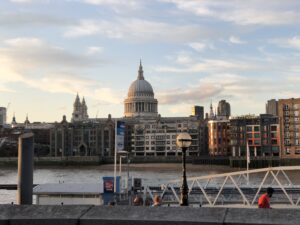
Over the years, countless English literature students have read plays by William Shakespeare and been told these plays were first performed at The Globe Theater.
The Globe was one of the first theaters in London. Initially, plays were performed on street corners and in the yards of inns which I’m sure served refreshments. In 1576 the City of London wanted its cut of the profits and required a license for theatrical events held in inn yards within the city limits.
Actor James Burbage decided to move performances outside of town, leased land in Shoreditch, and built The Theater on leased land. When the lease ran out, Burbage claimed the building was his to move. The landlord disagreed. Disgruntled actors, particularly members of the Lord Chamberlain’s Men, waited until the landlord was away, dismantled the building in December 1599 and eventually ferried the timbers over the Thames to Southwark, an entertainment district with animal baiting, brothels, tanneries, breweries, lumberyards and several other theaters, including The Swan, The Rose, and The Fortune.

The Globe was the most elaborate theater yet built and owned by Burbage’s two sons and five actors, including William Shakespeare who had 12.5 percent of the shares. Much of Shakespeare’s eventual wealth came from the profits.

The Globe was a round, wooden structure with a thatched roof. The covered galleries could seat about 1,000 viewers. The uncovered area included the stage and the pit below it which had space for 2,000 people. For a penny, these “groundlings” could stand on a rush strewn earthen floor. In summer the groundlings were called the Stinkards.

On play days, a flag flew above the theater. Red for a history play; white for comedy, and black for tragedy.

On June 29, 1613 actors fired a canon brought in for a scene in Henry VIII. The shot hit the wooden beams and straw thatch. The theater burned to the ground, but the only casualty was a man whose trousers caught fire. Quick-thinking bystanders doused the flamesGlobe beer.
In 1644 the Puritan government demolished all theaters. Academics and amateur theater lovers made the pilgrimage to the theater’s site. And in 1949 American actor Sam Wanamaker began a quest to rebuild a modern Globe. Twenty years later, Wannamaker began the project in earnest. As much as possible, the new theater is an authentic timber-framed reconstruction of the original.

One thousand green oak trees went into the timber frame that was cut and joined using 16th century methods. Special permission was granted to create a modern thatched roof from 6,000 bundles of water reeds. The design is based on samples found during archeologial excavations and protected by fire retardants and sprinklers.

The uncovered pit remains with standing room for new generations of groundlings who pay £5 for admission. No umbrellas allowed. The theater has no heat or air conditioning. But it does have an on-sight restaurant and bar called The Swan. Visiting Shakespeare’s Globe is a great way to spend an evening in London.
🌳🌳🌳
New Globe Theater from Thames side. By Aiwok
Exterior View of Globe Theater, 1612
Title page, First folio of Shakespeare plays. 1623
Other photos by Author.
Shakespeare’s Globe Theater Facts. No Sweat Shakespeare.
Rebuilding the Globe Theater. Inspired Diversions. April 11, 2006.
Bruce T. “History of the Globe Theater.” Theater Seat Store. Mar. 21, 2019.
Amanda Mabillard. “The Globe Theater.” Shakespeare Online. Aug. 20, 2006.

Sandra Wagner-Wright holds the doctoral degree in history and taught women’s and global history at the University of Hawai`i. Sandra travels for her research, most recently to Salem, Massachusetts, the setting of her new Salem Stories series. She also enjoys traveling for new experiences. Recent trips include Antarctica and a river cruise on the Rhine from Amsterdam to Basel.
Sandra particularly likes writing about strong women who make a difference. She lives in Hilo, Hawai`i with her family and writes a blog relating to history, travel, and the idiosyncrasies of life.

